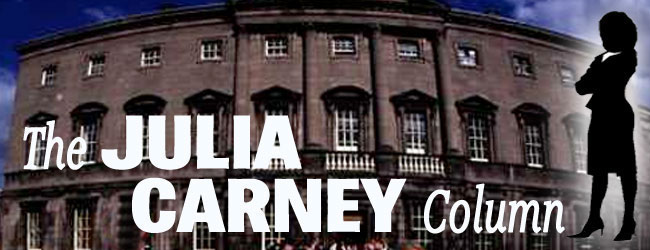4 March 2011
The rough beast that is Fine Gael
 THE WONDERS of the modern newspaper industry being what they are, I have to write this before polling day and you’ll be reading if afterwards. By now you’ll know how well Sinn Féin did and how badly Fianna Fáil dropped. We’ll all know whether Fine Gael has accomplished the previously thought impossible and formed a single-party government.
THE WONDERS of the modern newspaper industry being what they are, I have to write this before polling day and you’ll be reading if afterwards. By now you’ll know how well Sinn Féin did and how badly Fianna Fáil dropped. We’ll all know whether Fine Gael has accomplished the previously thought impossible and formed a single-party government.
At which point Pa Carney has sworn he will take up arms using long-hidden Old IRA stockpiles and his daughter Julia will be trying to slip out of the country and claim asylum in Cuba. You know the old saying: ‘First they came for the Labour Party, and I laughed because I never liked those smug, middle class, do-gooders . . . and then they came for me.’ (Something along those lines anyway.)
Fine Gael in power, absolute power, with the biggest newspapers in the country backing them, and no lily-livered Labour liberals to murmur even a futile, polite protest. They would go stark, staring mad.
Imagine it: Leo Varadkar and his mates hunting single mothers through Mulhuddart with dogs and shotguns. Lucinda Creighton making homeless people fight each other to the death for her own amusement, awarding the winner a bowl of thin gruel. The road from Enda Kenny’s constituency office in Mayo to Government Buildings lined with crucified public sector workers as a warning to all who may dare oppose them. And Brian Hayes, just think of what he could do as a minister.
It was all predicted, you know, many years ago by WB Yeats, who awoke one morning after a night cracking into the absinthe, possessed by a horror at a vision that had unfolded before him in his nightmares. He lashed out ‘The Second Coming’ the next day.
“Things fall apart; the centre cannot hold;
Mere anarchy is loosed upon the world.”
He begins by referring to the economic collapse (“Things fall apart”) before going on to point to the decline in the “centre” vote, for Labour and Fianna Fáil. This allows the mad anarchy of one-party Fine Gael rule to be unleashed on an unsuspecting world.
“The blood-dimmed tide is loosed, and everywhere
The ceremony of innocence is drowned.”
The blood imagery is a clear reference to the 30,000 public sector jobs to be cut. The drowning of the innocent is taken by many scholars to point to further cuts in Child Benefit payments, though some have suggested Fine Gael will actually drown the newborns of single mothers in some sort of religious ceremony as sacrifices to their dark, Lovecraftian gods.
“The best lack all conviction, while the worst
Are full of passionate intensity.”
Some Fine Gaelers are relatively harmless. They’re parish pump politicians, the useful idiots of the Blueshirt revolution, the ‘best’ of a bad lot. Your Catherine Byrne, for example, or your Michael Ring. They’re not conviction politicians; there’s no ideology there. They could as easily be in Fianna Fáil or Labour. But the worst, the hardcore, the ultras of the Fine Gael mob, are deeply and passionately committed to their assault on all that is good and decent in this world. And republicans.
“Surely some revelation is at hand;
Surely the Second Coming is at hand.”
The “first coming” was, of course, the 1923 Cumann na nGaedheal government, which managed to remain in power as a single-party minority government until Dev kicked them out in 1932. Incidentally, this is commemorated annually in the Fianna Fáil-supporting Carney family home with the burning of an effigy of Cosgrave and Pa Carney retelling the story of Grandpa Carney’s role in the assassination of Kevin O’Higgins. Good times.
Since then, the Fine Gaelers have only been able to govern with the help of the Labour Party, always willing to lend a hand in exchange for a few coppers on their ministerial pensions and the odd scrap for the poor. The ‘Second Coming’ that Yeats foresaw is the possibility of a second single-party Fine Gael government without the need for Labour.
“. . . somewhere in sands of the desert
A shape with lion body and the head of a man,
A gaze blank and pitiless as the sun,
Is moving its slow thighs, while all about it
Reel shadows of the indignant desert birds.”
Phil Hogan. Yeats wrote elsewhere that “I began to imagine as always at my left side just out of the range of sight, a brazen winged beast which I associated with laughing, ecstatic destruction.” He went on to say that this creature was described in ‘The Second Coming’. Always just out of sight, manipulating things behind the scenes, “laughing, ecstatic destruction” – could it be anyone other than Kenny’s puppet-master Hogan?
“And what rough beast, its hour come round at last,
Slouches towards Bethlehem to be born?”
“Bethlehem” in this context refers to Government Buildings. The “rough beast” is Fine Gael.
The poem ends at this point. It is rumoured that Yeats did write another verse but that publishers of the day believed its horrors to be too appalling, the evil deeds listed in it too shocking, for early 20th century readers.
By the time you read this, we may know what Yeats’s second verse truly contained.
Follow us on Facebook
An Phoblacht on Twitter
Uncomfortable Conversations

An initiative for dialogue
for reconciliation
— — — — — — —
Contributions from key figures in the churches, academia and wider civic society as well as senior republican figures




